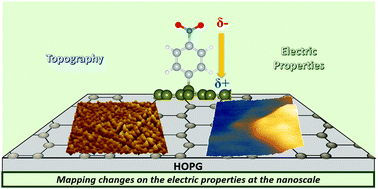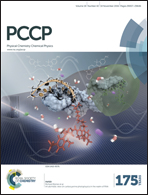Mapping nanometric electronic property changes induced by an aryl diazonium sub-monolayer on HOPG†
Abstract
The morphology as well as the electric and electronic properties of aryl diazonium, in particular 4-nitrobenzene-diazonium (NBD), films on HOPG surfaces have been studied at the nanoscale level. By controlling the 2,2-diphenyl-1-picrylhydrazyl concentration during the NBD film growth, we have been able to control the thickness of the layer. The implications of NBD submonolayer adsorption on the electrical properties of this system have been analysed through Density Functional Theory (DFT) calculations, Atomic Force (AFM), Electric Force (EFM) and Kelvin Probe Force (KPFM) microscopies. DFT simulations showed that the NBD molecule adsorbs almost perpendicularly to the HOPG surface, which was confirmed experimentally through AFM imaging in the dynamic mode. In addition, DFT calculations showed that the adsorbed NBD has an appreciable dipole moment directed towards the HOPG surface and along the vertical direction of the HOPG surface. The existence of this dipole is the origin of the EFM contrast observed between the NBD-free and NBD-covered regions when a bias of −2 V was applied to the tip. Besides, the KPFM measurements show that the NBD adsorption leads to higher work function values, which is in agreement with the DFT calculations. Noticeably, our studies show that the KPFM signal is sensitive to the partial NBD coverage of the HOPG surface below the monolayer level.


 Please wait while we load your content...
Please wait while we load your content...